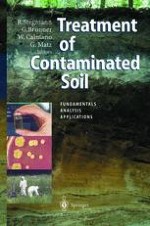2001 | OriginalPaper | Chapter
Bacterial Strategies to Improve the Bioavailability of Hydrophobic Organic Pollutants
Authors : L. Y. Wick, D. Springael, H. Harms
Published in: Treatment of Contaminated Soil
Publisher: Springer Berlin Heidelberg
Included in: Professional Book Archive
Activate our intelligent search to find suitable subject content or patents.
Select sections of text to find matching patents with Artificial Intelligence. powered by
Select sections of text to find additional relevant content using AI-assisted search. powered by
Bioremediation of polluted soil mostly depends on indigenous micro-organisms. The principle of engineered bioremediation is to stimulate those micro-organisms, which are able to degrade xenobiotic substrates (Aelion et al. 1987). The most often reported genera in degradation of anthropogenic pollutants include Ralstonia,Burkholderia, Comamonas, Arthrobacter, Mycobacterium,Nocardia, fluorescent Pseudomonas,Rhodococcus, and Sphingomonas (Haggblom and Valo 1995; Neilson 1995; Commandeur et al. 1995). In response to the introduction of electron acceptors (like oxygen) or nutrients to soil, specific degrader organisms will multiply. However, in spite of a potentially metabolically active biomass, in-situ bioremediation of soils polluted with hydrophobic organic pollutants (HOC) frequently results in slow pollutant degradation rates, high residual concentrations and, as a consequence, in limited clean-up efficiencies (Zhang et al. 1998; Luthy et al. 1994). The unequal spatial distribution of micro-organisms and pollutants in combination with physically retarded substrate diffusion are nowadays generally accepted as key limiting factors for efficient biodegradation of hydrophobic contaminants in soil.
